Post-operative Care & Pathophysiology: Right Hemicolectomy Case Study
VerifiedAdded on 2023/04/07
|14
|2794
|373
Case Study
AI Summary
This case study delves into the post-operative care of Eleanor, a 58-year-old woman who underwent a right hemicolectomy for adenocarcinoma. The analysis identifies key clinical priorities including hypovolemia (indicated by low hemoglobin and hematocrit levels), hypotension, management of vacuum drains, and care of the laparoscopic incision site. The study explores the pathophysiology of post-operative hypovolemia, detailing the body's compensatory mechanisms and potential complications such as kidney damage and organ failure. Nursing goals are outlined for each priority, emphasizing physical examination, blood pressure management, infection prevention, and surgical site assessment. Evidence-based rationales support the selected nursing goals, highlighting the importance of early detection and intervention to prevent adverse outcomes like multiple organ failure and surgical site infections. The case study underscores the critical role of nurses in monitoring patient vital signs, administering appropriate medications, and ensuring proper wound care to promote patient recovery and prevent complications.
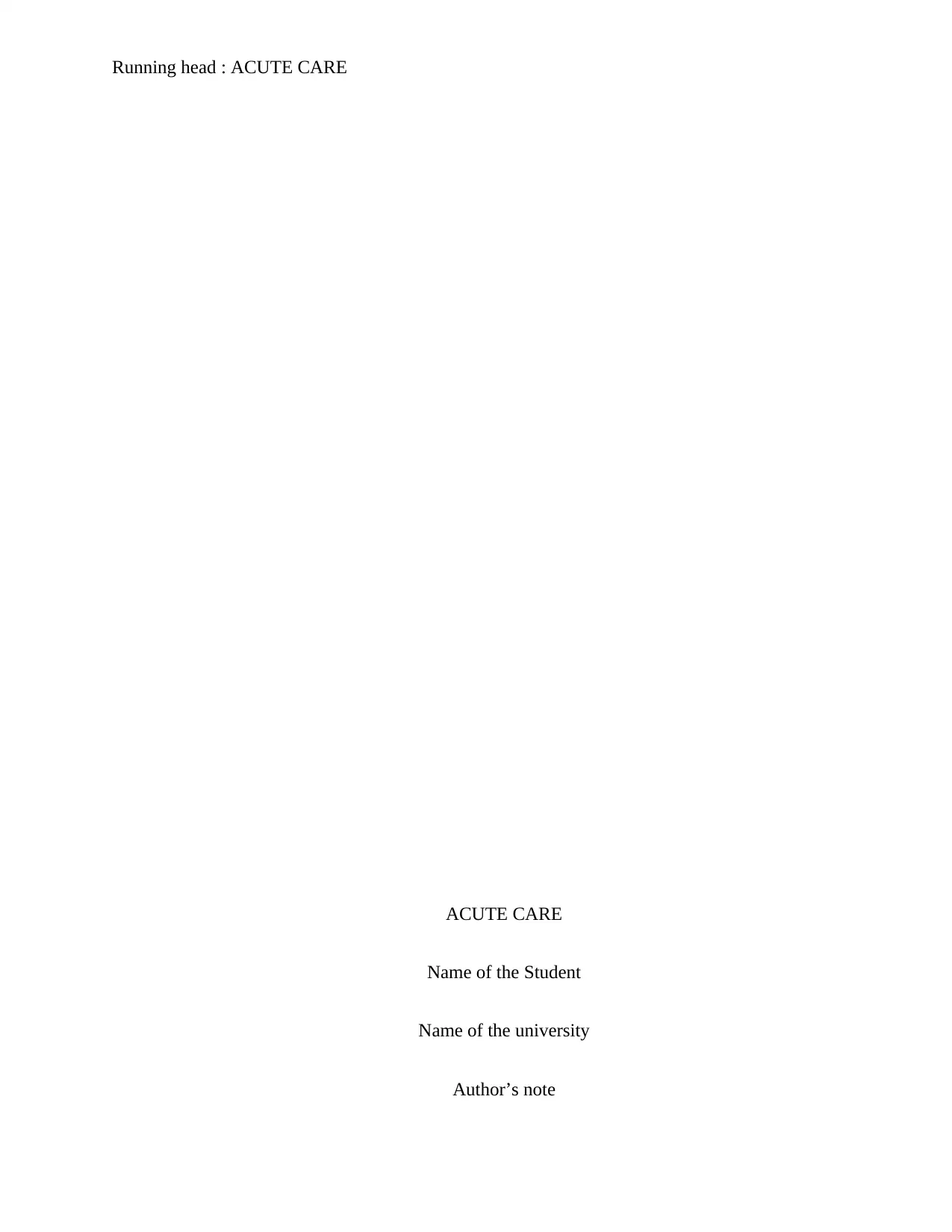
Running head : ACUTE CARE
ACUTE CARE
Name of the Student
Name of the university
Author’s note
ACUTE CARE
Name of the Student
Name of the university
Author’s note
Paraphrase This Document
Need a fresh take? Get an instant paraphrase of this document with our AI Paraphraser
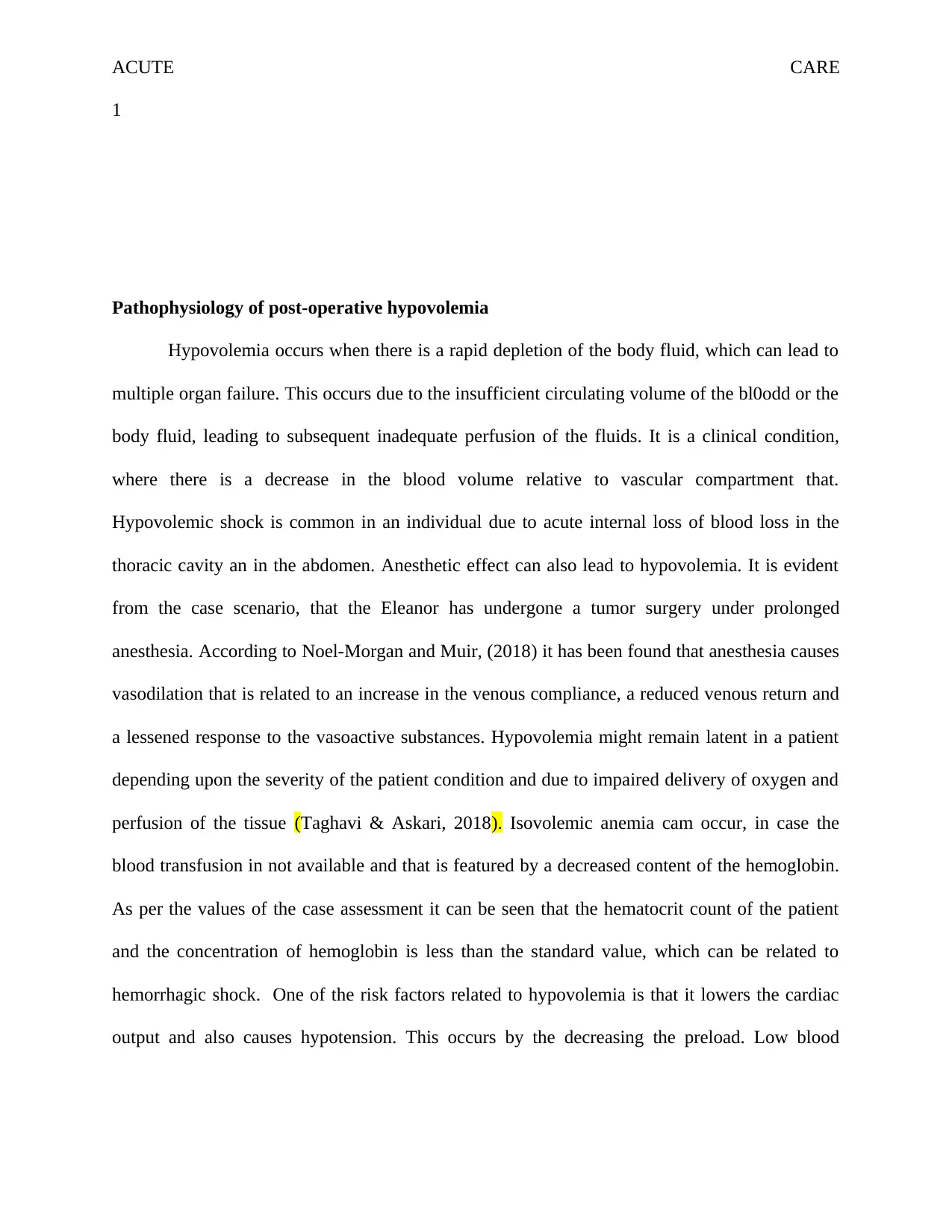
ACUTE CARE
1
Pathophysiology of post-operative hypovolemia
Hypovolemia occurs when there is a rapid depletion of the body fluid, which can lead to
multiple organ failure. This occurs due to the insufficient circulating volume of the bl0odd or the
body fluid, leading to subsequent inadequate perfusion of the fluids. It is a clinical condition,
where there is a decrease in the blood volume relative to vascular compartment that.
Hypovolemic shock is common in an individual due to acute internal loss of blood loss in the
thoracic cavity an in the abdomen. Anesthetic effect can also lead to hypovolemia. It is evident
from the case scenario, that the Eleanor has undergone a tumor surgery under prolonged
anesthesia. According to Noel-Morgan and Muir, (2018) it has been found that anesthesia causes
vasodilation that is related to an increase in the venous compliance, a reduced venous return and
a lessened response to the vasoactive substances. Hypovolemia might remain latent in a patient
depending upon the severity of the patient condition and due to impaired delivery of oxygen and
perfusion of the tissue (Taghavi & Askari, 2018). Isovolemic anemia cam occur, in case the
blood transfusion in not available and that is featured by a decreased content of the hemoglobin.
As per the values of the case assessment it can be seen that the hematocrit count of the patient
and the concentration of hemoglobin is less than the standard value, which can be related to
hemorrhagic shock. One of the risk factors related to hypovolemia is that it lowers the cardiac
output and also causes hypotension. This occurs by the decreasing the preload. Low blood
1
Pathophysiology of post-operative hypovolemia
Hypovolemia occurs when there is a rapid depletion of the body fluid, which can lead to
multiple organ failure. This occurs due to the insufficient circulating volume of the bl0odd or the
body fluid, leading to subsequent inadequate perfusion of the fluids. It is a clinical condition,
where there is a decrease in the blood volume relative to vascular compartment that.
Hypovolemic shock is common in an individual due to acute internal loss of blood loss in the
thoracic cavity an in the abdomen. Anesthetic effect can also lead to hypovolemia. It is evident
from the case scenario, that the Eleanor has undergone a tumor surgery under prolonged
anesthesia. According to Noel-Morgan and Muir, (2018) it has been found that anesthesia causes
vasodilation that is related to an increase in the venous compliance, a reduced venous return and
a lessened response to the vasoactive substances. Hypovolemia might remain latent in a patient
depending upon the severity of the patient condition and due to impaired delivery of oxygen and
perfusion of the tissue (Taghavi & Askari, 2018). Isovolemic anemia cam occur, in case the
blood transfusion in not available and that is featured by a decreased content of the hemoglobin.
As per the values of the case assessment it can be seen that the hematocrit count of the patient
and the concentration of hemoglobin is less than the standard value, which can be related to
hemorrhagic shock. One of the risk factors related to hypovolemia is that it lowers the cardiac
output and also causes hypotension. This occurs by the decreasing the preload. Low blood
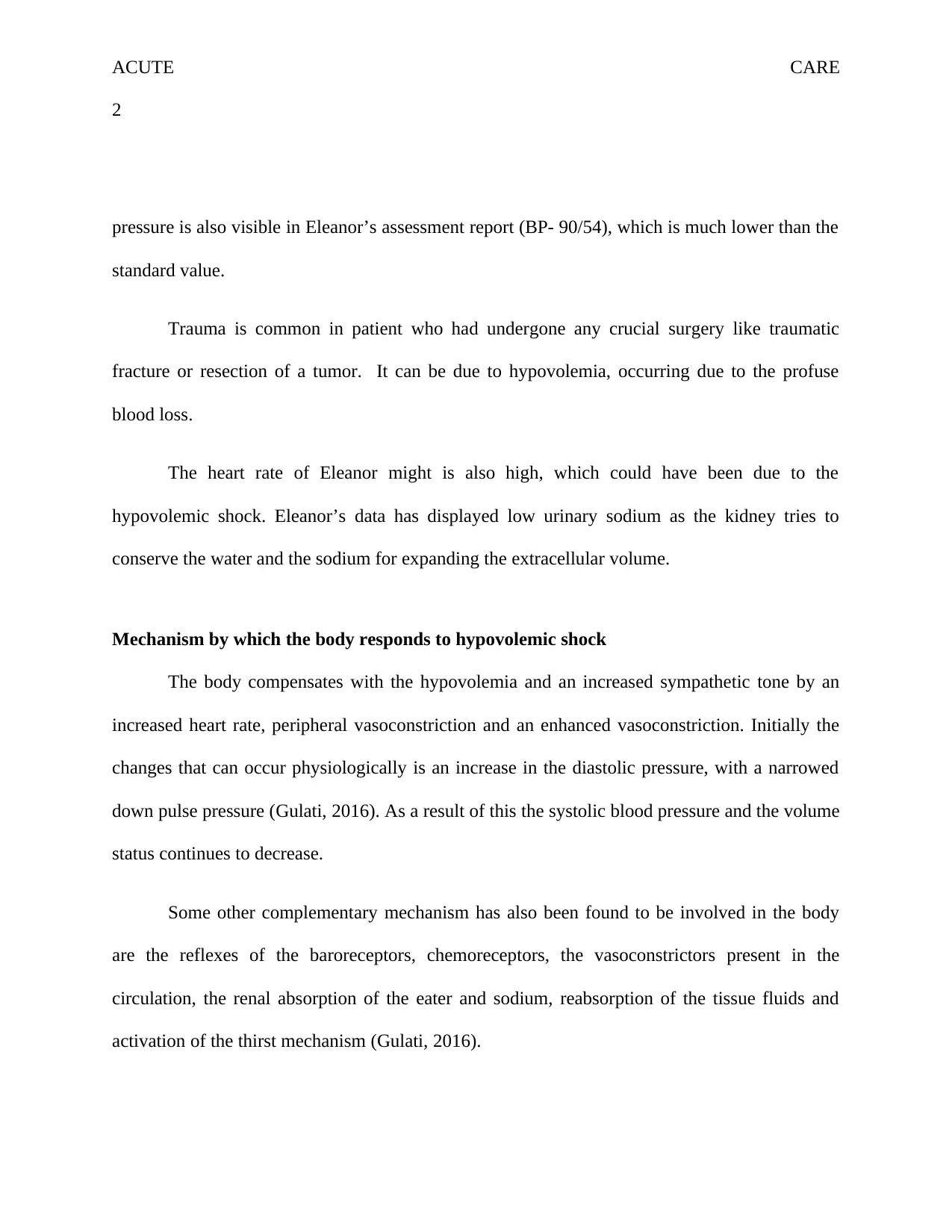
ACUTE CARE
2
pressure is also visible in Eleanor’s assessment report (BP- 90/54), which is much lower than the
standard value.
Trauma is common in patient who had undergone any crucial surgery like traumatic
fracture or resection of a tumor. It can be due to hypovolemia, occurring due to the profuse
blood loss.
The heart rate of Eleanor might is also high, which could have been due to the
hypovolemic shock. Eleanor’s data has displayed low urinary sodium as the kidney tries to
conserve the water and the sodium for expanding the extracellular volume.
Mechanism by which the body responds to hypovolemic shock
The body compensates with the hypovolemia and an increased sympathetic tone by an
increased heart rate, peripheral vasoconstriction and an enhanced vasoconstriction. Initially the
changes that can occur physiologically is an increase in the diastolic pressure, with a narrowed
down pulse pressure (Gulati, 2016). As a result of this the systolic blood pressure and the volume
status continues to decrease.
Some other complementary mechanism has also been found to be involved in the body
are the reflexes of the baroreceptors, chemoreceptors, the vasoconstrictors present in the
circulation, the renal absorption of the eater and sodium, reabsorption of the tissue fluids and
activation of the thirst mechanism (Gulati, 2016).
2
pressure is also visible in Eleanor’s assessment report (BP- 90/54), which is much lower than the
standard value.
Trauma is common in patient who had undergone any crucial surgery like traumatic
fracture or resection of a tumor. It can be due to hypovolemia, occurring due to the profuse
blood loss.
The heart rate of Eleanor might is also high, which could have been due to the
hypovolemic shock. Eleanor’s data has displayed low urinary sodium as the kidney tries to
conserve the water and the sodium for expanding the extracellular volume.
Mechanism by which the body responds to hypovolemic shock
The body compensates with the hypovolemia and an increased sympathetic tone by an
increased heart rate, peripheral vasoconstriction and an enhanced vasoconstriction. Initially the
changes that can occur physiologically is an increase in the diastolic pressure, with a narrowed
down pulse pressure (Gulati, 2016). As a result of this the systolic blood pressure and the volume
status continues to decrease.
Some other complementary mechanism has also been found to be involved in the body
are the reflexes of the baroreceptors, chemoreceptors, the vasoconstrictors present in the
circulation, the renal absorption of the eater and sodium, reabsorption of the tissue fluids and
activation of the thirst mechanism (Gulati, 2016).
⊘ This is a preview!⊘
Do you want full access?
Subscribe today to unlock all pages.

Trusted by 1+ million students worldwide
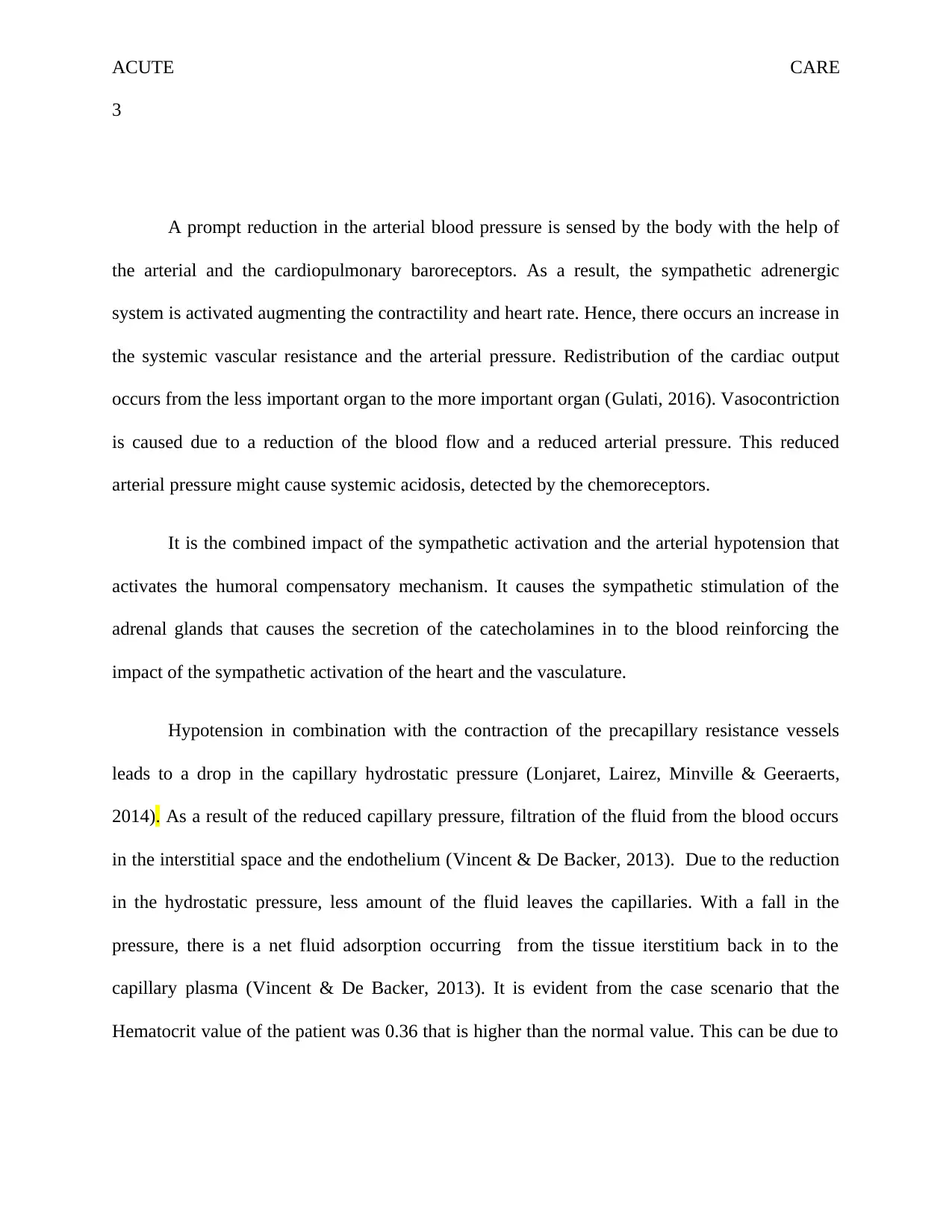
ACUTE CARE
3
A prompt reduction in the arterial blood pressure is sensed by the body with the help of
the arterial and the cardiopulmonary baroreceptors. As a result, the sympathetic adrenergic
system is activated augmenting the contractility and heart rate. Hence, there occurs an increase in
the systemic vascular resistance and the arterial pressure. Redistribution of the cardiac output
occurs from the less important organ to the more important organ (Gulati, 2016). Vasocontriction
is caused due to a reduction of the blood flow and a reduced arterial pressure. This reduced
arterial pressure might cause systemic acidosis, detected by the chemoreceptors.
It is the combined impact of the sympathetic activation and the arterial hypotension that
activates the humoral compensatory mechanism. It causes the sympathetic stimulation of the
adrenal glands that causes the secretion of the catecholamines in to the blood reinforcing the
impact of the sympathetic activation of the heart and the vasculature.
Hypotension in combination with the contraction of the precapillary resistance vessels
leads to a drop in the capillary hydrostatic pressure (Lonjaret, Lairez, Minville & Geeraerts,
2014). As a result of the reduced capillary pressure, filtration of the fluid from the blood occurs
in the interstitial space and the endothelium (Vincent & De Backer, 2013). Due to the reduction
in the hydrostatic pressure, less amount of the fluid leaves the capillaries. With a fall in the
pressure, there is a net fluid adsorption occurring from the tissue iterstitium back in to the
capillary plasma (Vincent & De Backer, 2013). It is evident from the case scenario that the
Hematocrit value of the patient was 0.36 that is higher than the normal value. This can be due to
3
A prompt reduction in the arterial blood pressure is sensed by the body with the help of
the arterial and the cardiopulmonary baroreceptors. As a result, the sympathetic adrenergic
system is activated augmenting the contractility and heart rate. Hence, there occurs an increase in
the systemic vascular resistance and the arterial pressure. Redistribution of the cardiac output
occurs from the less important organ to the more important organ (Gulati, 2016). Vasocontriction
is caused due to a reduction of the blood flow and a reduced arterial pressure. This reduced
arterial pressure might cause systemic acidosis, detected by the chemoreceptors.
It is the combined impact of the sympathetic activation and the arterial hypotension that
activates the humoral compensatory mechanism. It causes the sympathetic stimulation of the
adrenal glands that causes the secretion of the catecholamines in to the blood reinforcing the
impact of the sympathetic activation of the heart and the vasculature.
Hypotension in combination with the contraction of the precapillary resistance vessels
leads to a drop in the capillary hydrostatic pressure (Lonjaret, Lairez, Minville & Geeraerts,
2014). As a result of the reduced capillary pressure, filtration of the fluid from the blood occurs
in the interstitial space and the endothelium (Vincent & De Backer, 2013). Due to the reduction
in the hydrostatic pressure, less amount of the fluid leaves the capillaries. With a fall in the
pressure, there is a net fluid adsorption occurring from the tissue iterstitium back in to the
capillary plasma (Vincent & De Backer, 2013). It is evident from the case scenario that the
Hematocrit value of the patient was 0.36 that is higher than the normal value. This can be due to
Paraphrase This Document
Need a fresh take? Get an instant paraphrase of this document with our AI Paraphraser
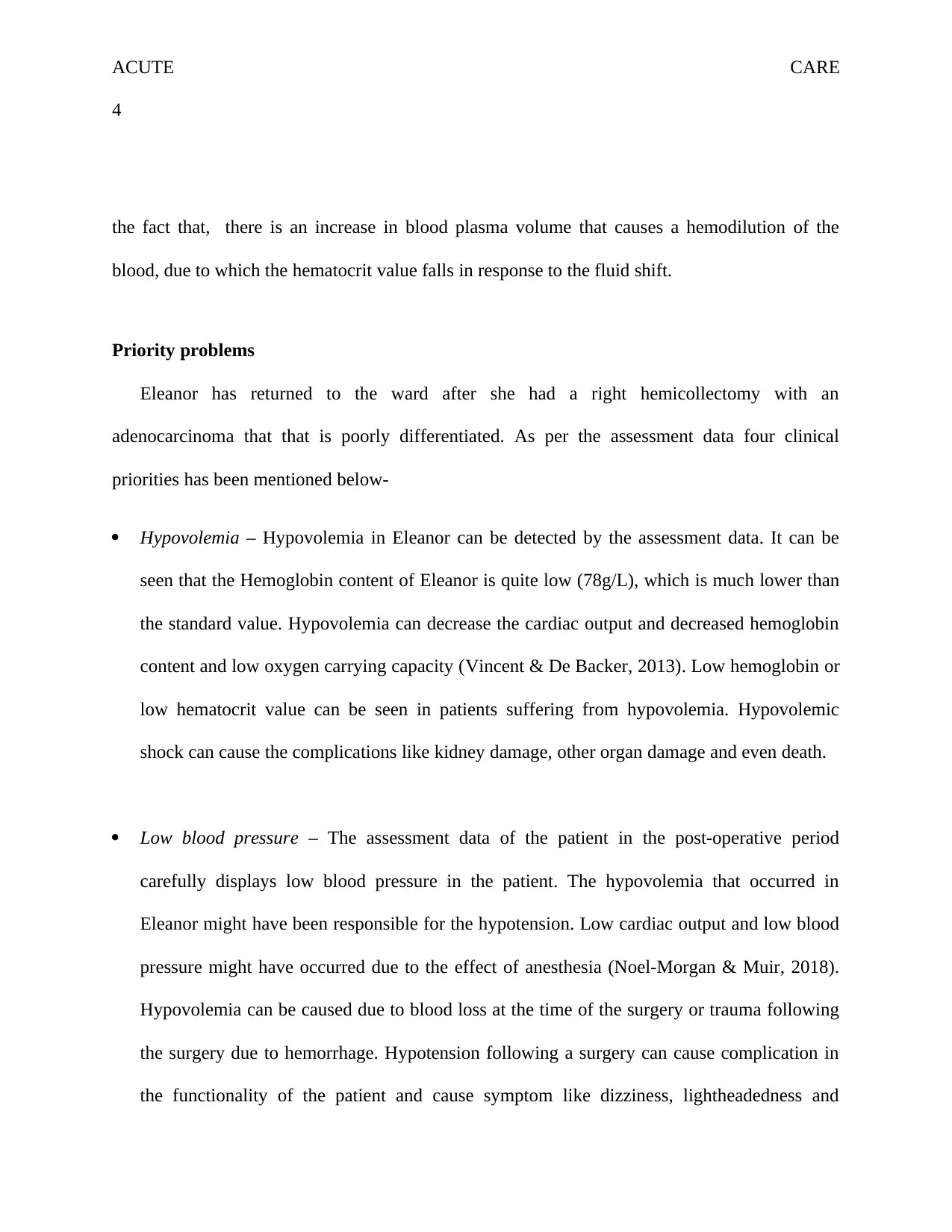
ACUTE CARE
4
the fact that, there is an increase in blood plasma volume that causes a hemodilution of the
blood, due to which the hematocrit value falls in response to the fluid shift.
Priority problems
Eleanor has returned to the ward after she had a right hemicollectomy with an
adenocarcinoma that that is poorly differentiated. As per the assessment data four clinical
priorities has been mentioned below-
Hypovolemia – Hypovolemia in Eleanor can be detected by the assessment data. It can be
seen that the Hemoglobin content of Eleanor is quite low (78g/L), which is much lower than
the standard value. Hypovolemia can decrease the cardiac output and decreased hemoglobin
content and low oxygen carrying capacity (Vincent & De Backer, 2013). Low hemoglobin or
low hematocrit value can be seen in patients suffering from hypovolemia. Hypovolemic
shock can cause the complications like kidney damage, other organ damage and even death.
Low blood pressure – The assessment data of the patient in the post-operative period
carefully displays low blood pressure in the patient. The hypovolemia that occurred in
Eleanor might have been responsible for the hypotension. Low cardiac output and low blood
pressure might have occurred due to the effect of anesthesia (Noel-Morgan & Muir, 2018).
Hypovolemia can be caused due to blood loss at the time of the surgery or trauma following
the surgery due to hemorrhage. Hypotension following a surgery can cause complication in
the functionality of the patient and cause symptom like dizziness, lightheadedness and
4
the fact that, there is an increase in blood plasma volume that causes a hemodilution of the
blood, due to which the hematocrit value falls in response to the fluid shift.
Priority problems
Eleanor has returned to the ward after she had a right hemicollectomy with an
adenocarcinoma that that is poorly differentiated. As per the assessment data four clinical
priorities has been mentioned below-
Hypovolemia – Hypovolemia in Eleanor can be detected by the assessment data. It can be
seen that the Hemoglobin content of Eleanor is quite low (78g/L), which is much lower than
the standard value. Hypovolemia can decrease the cardiac output and decreased hemoglobin
content and low oxygen carrying capacity (Vincent & De Backer, 2013). Low hemoglobin or
low hematocrit value can be seen in patients suffering from hypovolemia. Hypovolemic
shock can cause the complications like kidney damage, other organ damage and even death.
Low blood pressure – The assessment data of the patient in the post-operative period
carefully displays low blood pressure in the patient. The hypovolemia that occurred in
Eleanor might have been responsible for the hypotension. Low cardiac output and low blood
pressure might have occurred due to the effect of anesthesia (Noel-Morgan & Muir, 2018).
Hypovolemia can be caused due to blood loss at the time of the surgery or trauma following
the surgery due to hemorrhage. Hypotension following a surgery can cause complication in
the functionality of the patient and cause symptom like dizziness, lightheadedness and
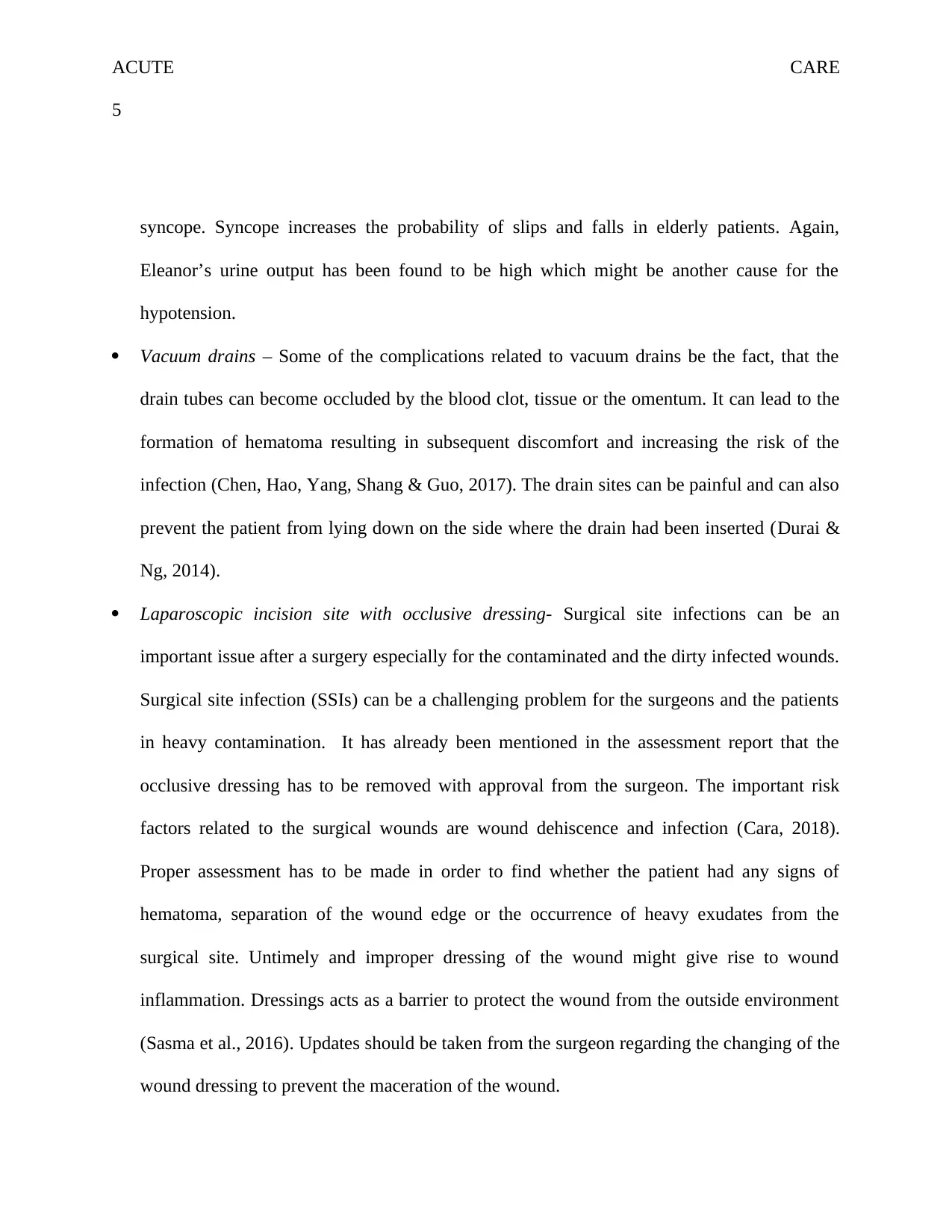
ACUTE CARE
5
syncope. Syncope increases the probability of slips and falls in elderly patients. Again,
Eleanor’s urine output has been found to be high which might be another cause for the
hypotension.
Vacuum drains – Some of the complications related to vacuum drains be the fact, that the
drain tubes can become occluded by the blood clot, tissue or the omentum. It can lead to the
formation of hematoma resulting in subsequent discomfort and increasing the risk of the
infection (Chen, Hao, Yang, Shang & Guo, 2017). The drain sites can be painful and can also
prevent the patient from lying down on the side where the drain had been inserted (Durai &
Ng, 2014).
Laparoscopic incision site with occlusive dressing- Surgical site infections can be an
important issue after a surgery especially for the contaminated and the dirty infected wounds.
Surgical site infection (SSIs) can be a challenging problem for the surgeons and the patients
in heavy contamination. It has already been mentioned in the assessment report that the
occlusive dressing has to be removed with approval from the surgeon. The important risk
factors related to the surgical wounds are wound dehiscence and infection (Cara, 2018).
Proper assessment has to be made in order to find whether the patient had any signs of
hematoma, separation of the wound edge or the occurrence of heavy exudates from the
surgical site. Untimely and improper dressing of the wound might give rise to wound
inflammation. Dressings acts as a barrier to protect the wound from the outside environment
(Sasma et al., 2016). Updates should be taken from the surgeon regarding the changing of the
wound dressing to prevent the maceration of the wound.
5
syncope. Syncope increases the probability of slips and falls in elderly patients. Again,
Eleanor’s urine output has been found to be high which might be another cause for the
hypotension.
Vacuum drains – Some of the complications related to vacuum drains be the fact, that the
drain tubes can become occluded by the blood clot, tissue or the omentum. It can lead to the
formation of hematoma resulting in subsequent discomfort and increasing the risk of the
infection (Chen, Hao, Yang, Shang & Guo, 2017). The drain sites can be painful and can also
prevent the patient from lying down on the side where the drain had been inserted (Durai &
Ng, 2014).
Laparoscopic incision site with occlusive dressing- Surgical site infections can be an
important issue after a surgery especially for the contaminated and the dirty infected wounds.
Surgical site infection (SSIs) can be a challenging problem for the surgeons and the patients
in heavy contamination. It has already been mentioned in the assessment report that the
occlusive dressing has to be removed with approval from the surgeon. The important risk
factors related to the surgical wounds are wound dehiscence and infection (Cara, 2018).
Proper assessment has to be made in order to find whether the patient had any signs of
hematoma, separation of the wound edge or the occurrence of heavy exudates from the
surgical site. Untimely and improper dressing of the wound might give rise to wound
inflammation. Dressings acts as a barrier to protect the wound from the outside environment
(Sasma et al., 2016). Updates should be taken from the surgeon regarding the changing of the
wound dressing to prevent the maceration of the wound.
⊘ This is a preview!⊘
Do you want full access?
Subscribe today to unlock all pages.

Trusted by 1+ million students worldwide
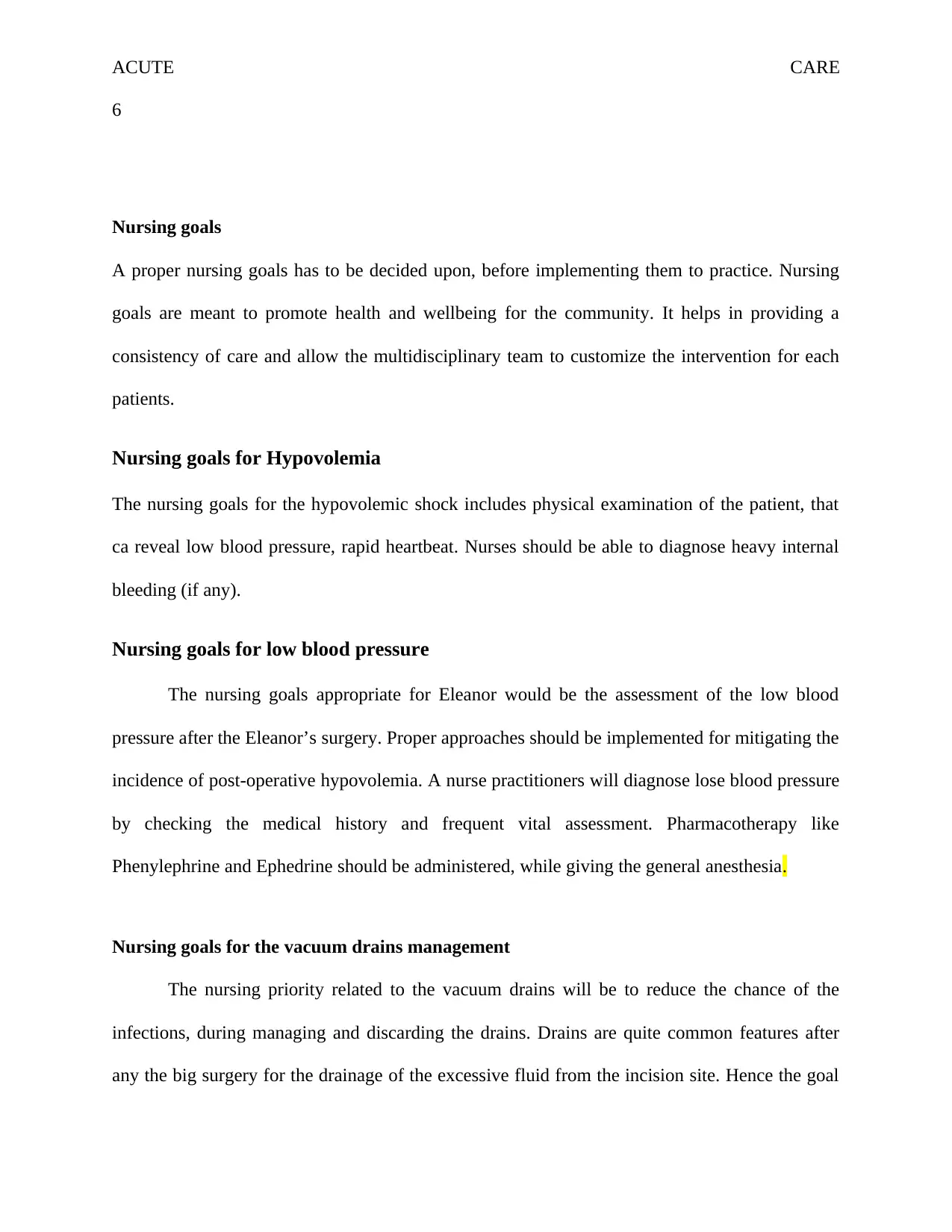
ACUTE CARE
6
Nursing goals
A proper nursing goals has to be decided upon, before implementing them to practice. Nursing
goals are meant to promote health and wellbeing for the community. It helps in providing a
consistency of care and allow the multidisciplinary team to customize the intervention for each
patients.
Nursing goals for Hypovolemia
The nursing goals for the hypovolemic shock includes physical examination of the patient, that
ca reveal low blood pressure, rapid heartbeat. Nurses should be able to diagnose heavy internal
bleeding (if any).
Nursing goals for low blood pressure
The nursing goals appropriate for Eleanor would be the assessment of the low blood
pressure after the Eleanor’s surgery. Proper approaches should be implemented for mitigating the
incidence of post-operative hypovolemia. A nurse practitioners will diagnose lose blood pressure
by checking the medical history and frequent vital assessment. Pharmacotherapy like
Phenylephrine and Ephedrine should be administered, while giving the general anesthesia.
Nursing goals for the vacuum drains management
The nursing priority related to the vacuum drains will be to reduce the chance of the
infections, during managing and discarding the drains. Drains are quite common features after
any the big surgery for the drainage of the excessive fluid from the incision site. Hence the goal
6
Nursing goals
A proper nursing goals has to be decided upon, before implementing them to practice. Nursing
goals are meant to promote health and wellbeing for the community. It helps in providing a
consistency of care and allow the multidisciplinary team to customize the intervention for each
patients.
Nursing goals for Hypovolemia
The nursing goals for the hypovolemic shock includes physical examination of the patient, that
ca reveal low blood pressure, rapid heartbeat. Nurses should be able to diagnose heavy internal
bleeding (if any).
Nursing goals for low blood pressure
The nursing goals appropriate for Eleanor would be the assessment of the low blood
pressure after the Eleanor’s surgery. Proper approaches should be implemented for mitigating the
incidence of post-operative hypovolemia. A nurse practitioners will diagnose lose blood pressure
by checking the medical history and frequent vital assessment. Pharmacotherapy like
Phenylephrine and Ephedrine should be administered, while giving the general anesthesia.
Nursing goals for the vacuum drains management
The nursing priority related to the vacuum drains will be to reduce the chance of the
infections, during managing and discarding the drains. Drains are quite common features after
any the big surgery for the drainage of the excessive fluid from the incision site. Hence the goal
Paraphrase This Document
Need a fresh take? Get an instant paraphrase of this document with our AI Paraphraser
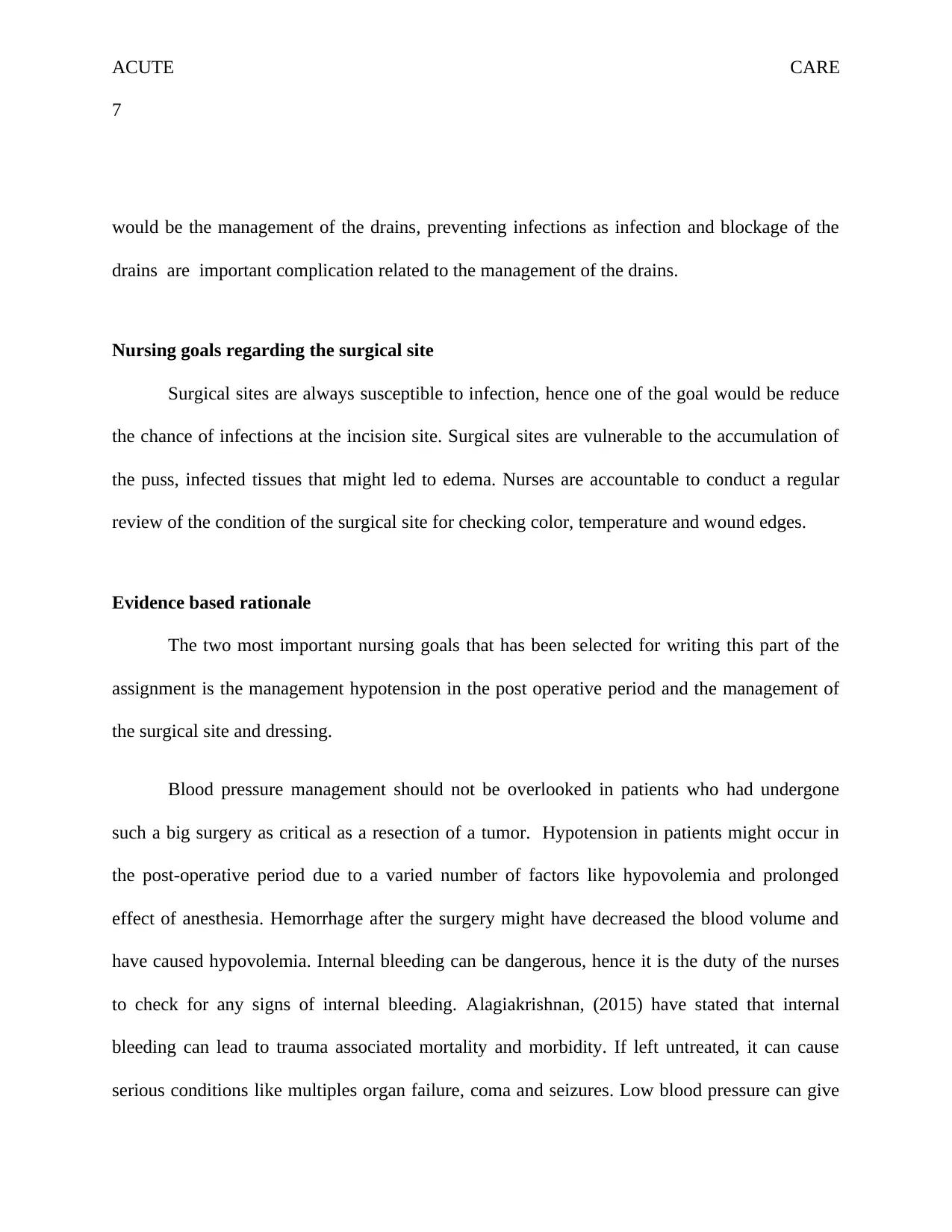
ACUTE CARE
7
would be the management of the drains, preventing infections as infection and blockage of the
drains are important complication related to the management of the drains.
Nursing goals regarding the surgical site
Surgical sites are always susceptible to infection, hence one of the goal would be reduce
the chance of infections at the incision site. Surgical sites are vulnerable to the accumulation of
the puss, infected tissues that might led to edema. Nurses are accountable to conduct a regular
review of the condition of the surgical site for checking color, temperature and wound edges.
Evidence based rationale
The two most important nursing goals that has been selected for writing this part of the
assignment is the management hypotension in the post operative period and the management of
the surgical site and dressing.
Blood pressure management should not be overlooked in patients who had undergone
such a big surgery as critical as a resection of a tumor. Hypotension in patients might occur in
the post-operative period due to a varied number of factors like hypovolemia and prolonged
effect of anesthesia. Hemorrhage after the surgery might have decreased the blood volume and
have caused hypovolemia. Internal bleeding can be dangerous, hence it is the duty of the nurses
to check for any signs of internal bleeding. Alagiakrishnan, (2015) have stated that internal
bleeding can lead to trauma associated mortality and morbidity. If left untreated, it can cause
serious conditions like multiples organ failure, coma and seizures. Low blood pressure can give
7
would be the management of the drains, preventing infections as infection and blockage of the
drains are important complication related to the management of the drains.
Nursing goals regarding the surgical site
Surgical sites are always susceptible to infection, hence one of the goal would be reduce
the chance of infections at the incision site. Surgical sites are vulnerable to the accumulation of
the puss, infected tissues that might led to edema. Nurses are accountable to conduct a regular
review of the condition of the surgical site for checking color, temperature and wound edges.
Evidence based rationale
The two most important nursing goals that has been selected for writing this part of the
assignment is the management hypotension in the post operative period and the management of
the surgical site and dressing.
Blood pressure management should not be overlooked in patients who had undergone
such a big surgery as critical as a resection of a tumor. Hypotension in patients might occur in
the post-operative period due to a varied number of factors like hypovolemia and prolonged
effect of anesthesia. Hemorrhage after the surgery might have decreased the blood volume and
have caused hypovolemia. Internal bleeding can be dangerous, hence it is the duty of the nurses
to check for any signs of internal bleeding. Alagiakrishnan, (2015) have stated that internal
bleeding can lead to trauma associated mortality and morbidity. If left untreated, it can cause
serious conditions like multiples organ failure, coma and seizures. Low blood pressure can give
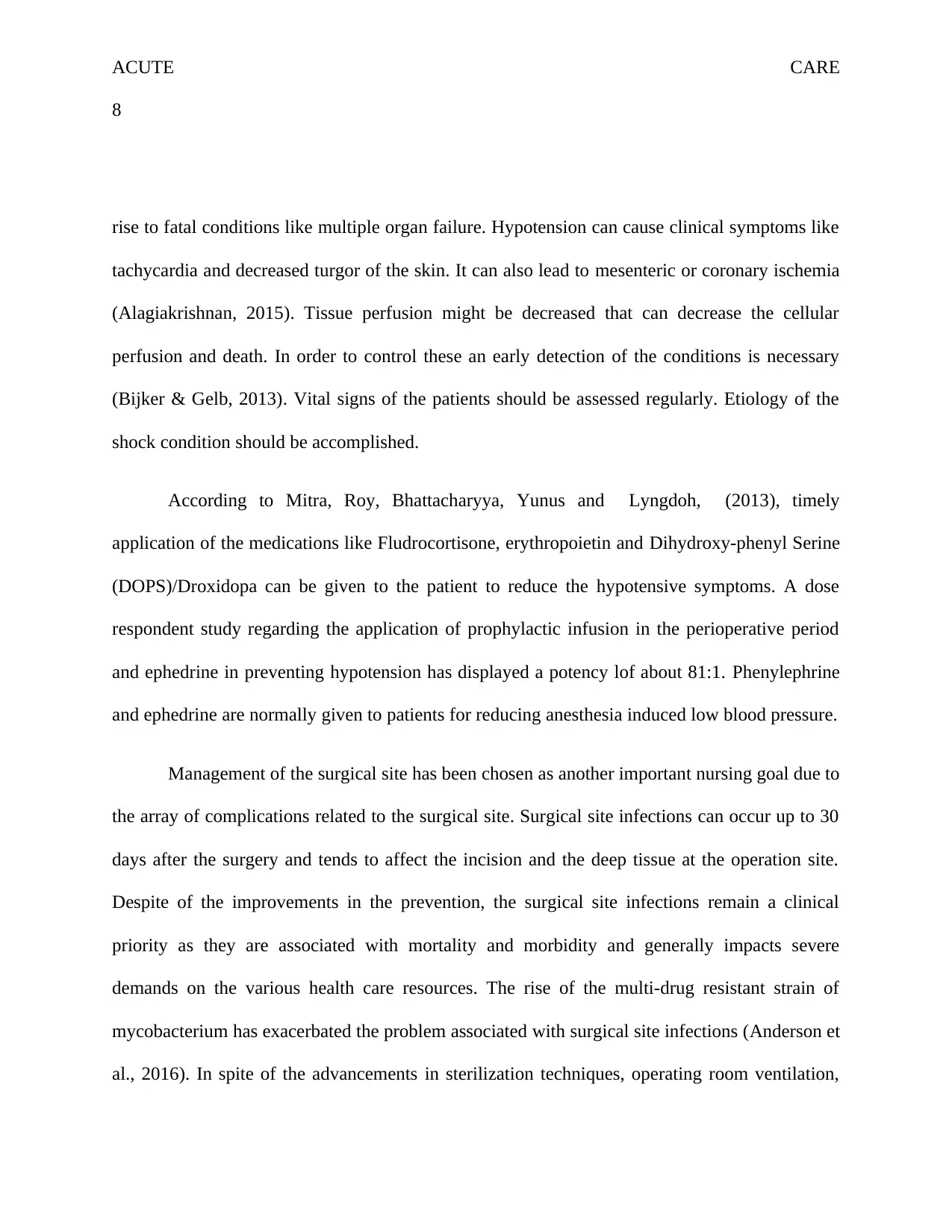
ACUTE CARE
8
rise to fatal conditions like multiple organ failure. Hypotension can cause clinical symptoms like
tachycardia and decreased turgor of the skin. It can also lead to mesenteric or coronary ischemia
(Alagiakrishnan, 2015). Tissue perfusion might be decreased that can decrease the cellular
perfusion and death. In order to control these an early detection of the conditions is necessary
(Bijker & Gelb, 2013). Vital signs of the patients should be assessed regularly. Etiology of the
shock condition should be accomplished.
According to Mitra, Roy, Bhattacharyya, Yunus and Lyngdoh, (2013), timely
application of the medications like Fludrocortisone, erythropoietin and Dihydroxy-phenyl Serine
(DOPS)/Droxidopa can be given to the patient to reduce the hypotensive symptoms. A dose
respondent study regarding the application of prophylactic infusion in the perioperative period
and ephedrine in preventing hypotension has displayed a potency lof about 81:1. Phenylephrine
and ephedrine are normally given to patients for reducing anesthesia induced low blood pressure.
Management of the surgical site has been chosen as another important nursing goal due to
the array of complications related to the surgical site. Surgical site infections can occur up to 30
days after the surgery and tends to affect the incision and the deep tissue at the operation site.
Despite of the improvements in the prevention, the surgical site infections remain a clinical
priority as they are associated with mortality and morbidity and generally impacts severe
demands on the various health care resources. The rise of the multi-drug resistant strain of
mycobacterium has exacerbated the problem associated with surgical site infections (Anderson et
al., 2016). In spite of the advancements in sterilization techniques, operating room ventilation,
8
rise to fatal conditions like multiple organ failure. Hypotension can cause clinical symptoms like
tachycardia and decreased turgor of the skin. It can also lead to mesenteric or coronary ischemia
(Alagiakrishnan, 2015). Tissue perfusion might be decreased that can decrease the cellular
perfusion and death. In order to control these an early detection of the conditions is necessary
(Bijker & Gelb, 2013). Vital signs of the patients should be assessed regularly. Etiology of the
shock condition should be accomplished.
According to Mitra, Roy, Bhattacharyya, Yunus and Lyngdoh, (2013), timely
application of the medications like Fludrocortisone, erythropoietin and Dihydroxy-phenyl Serine
(DOPS)/Droxidopa can be given to the patient to reduce the hypotensive symptoms. A dose
respondent study regarding the application of prophylactic infusion in the perioperative period
and ephedrine in preventing hypotension has displayed a potency lof about 81:1. Phenylephrine
and ephedrine are normally given to patients for reducing anesthesia induced low blood pressure.
Management of the surgical site has been chosen as another important nursing goal due to
the array of complications related to the surgical site. Surgical site infections can occur up to 30
days after the surgery and tends to affect the incision and the deep tissue at the operation site.
Despite of the improvements in the prevention, the surgical site infections remain a clinical
priority as they are associated with mortality and morbidity and generally impacts severe
demands on the various health care resources. The rise of the multi-drug resistant strain of
mycobacterium has exacerbated the problem associated with surgical site infections (Anderson et
al., 2016). In spite of the advancements in sterilization techniques, operating room ventilation,
⊘ This is a preview!⊘
Do you want full access?
Subscribe today to unlock all pages.

Trusted by 1+ million students worldwide
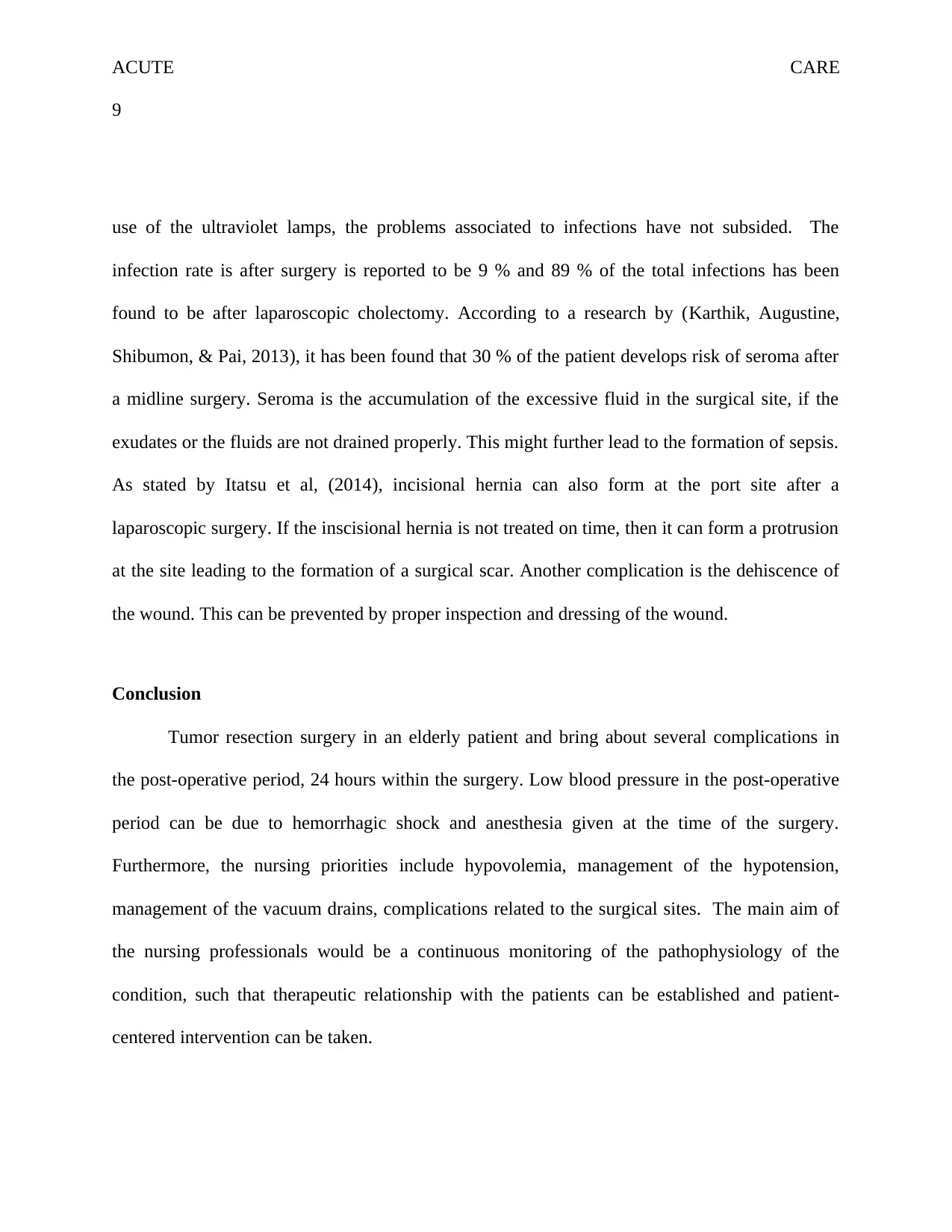
ACUTE CARE
9
use of the ultraviolet lamps, the problems associated to infections have not subsided. The
infection rate is after surgery is reported to be 9 % and 89 % of the total infections has been
found to be after laparoscopic cholectomy. According to a research by (Karthik, Augustine,
Shibumon, & Pai, 2013), it has been found that 30 % of the patient develops risk of seroma after
a midline surgery. Seroma is the accumulation of the excessive fluid in the surgical site, if the
exudates or the fluids are not drained properly. This might further lead to the formation of sepsis.
As stated by Itatsu et al, (2014), incisional hernia can also form at the port site after a
laparoscopic surgery. If the inscisional hernia is not treated on time, then it can form a protrusion
at the site leading to the formation of a surgical scar. Another complication is the dehiscence of
the wound. This can be prevented by proper inspection and dressing of the wound.
Conclusion
Tumor resection surgery in an elderly patient and bring about several complications in
the post-operative period, 24 hours within the surgery. Low blood pressure in the post-operative
period can be due to hemorrhagic shock and anesthesia given at the time of the surgery.
Furthermore, the nursing priorities include hypovolemia, management of the hypotension,
management of the vacuum drains, complications related to the surgical sites. The main aim of
the nursing professionals would be a continuous monitoring of the pathophysiology of the
condition, such that therapeutic relationship with the patients can be established and patient-
centered intervention can be taken.
9
use of the ultraviolet lamps, the problems associated to infections have not subsided. The
infection rate is after surgery is reported to be 9 % and 89 % of the total infections has been
found to be after laparoscopic cholectomy. According to a research by (Karthik, Augustine,
Shibumon, & Pai, 2013), it has been found that 30 % of the patient develops risk of seroma after
a midline surgery. Seroma is the accumulation of the excessive fluid in the surgical site, if the
exudates or the fluids are not drained properly. This might further lead to the formation of sepsis.
As stated by Itatsu et al, (2014), incisional hernia can also form at the port site after a
laparoscopic surgery. If the inscisional hernia is not treated on time, then it can form a protrusion
at the site leading to the formation of a surgical scar. Another complication is the dehiscence of
the wound. This can be prevented by proper inspection and dressing of the wound.
Conclusion
Tumor resection surgery in an elderly patient and bring about several complications in
the post-operative period, 24 hours within the surgery. Low blood pressure in the post-operative
period can be due to hemorrhagic shock and anesthesia given at the time of the surgery.
Furthermore, the nursing priorities include hypovolemia, management of the hypotension,
management of the vacuum drains, complications related to the surgical sites. The main aim of
the nursing professionals would be a continuous monitoring of the pathophysiology of the
condition, such that therapeutic relationship with the patients can be established and patient-
centered intervention can be taken.
Paraphrase This Document
Need a fresh take? Get an instant paraphrase of this document with our AI Paraphraser

ACUTE CARE
10
10

ACUTE CARE
11
Reference
Alagiakrishnan, K. (2015). Current pharmacological management of hypotensive syndromes in
the elderly. Drugs & aging, 32(5), 337-348. DOI https://doi.org/10.1007/s40266-015-
0263-z
Anderson, D. J., Podgorny, K., Berrios-Torres, S. I., Bratzler, D. W., Dellinger, E. P., Greene, L.,
... & Kaye, K. S. (2014). Strategies to prevent surgical site infections in acute care
hospitals: 2014 update. Infection Control & Hospital Epidemiology, 35(S2), S66-S88.
https://doi.org/10.1017/S0899823X0019386
Bijker, J. B., & Gelb, A. W. (2013). The role of hypotension in perioperative stroke. Canadian
Journal of Anesthesia/Journal canadien d'anesthésie, 60(2), 159-167. DOI
https://doi.org/10.1007/s12630-012-9857-7
Cara, C. (2018). An unusual case study: Collaborative management of an a typical wound.
Wound Practice & Research: Journal of the Australian Wound Management Association,
26(1), 34. https://www.racgp.org.au/afp/2013/december/post-operative-wound-
management/doi: 10.4103/0972-9941.110964
11
Reference
Alagiakrishnan, K. (2015). Current pharmacological management of hypotensive syndromes in
the elderly. Drugs & aging, 32(5), 337-348. DOI https://doi.org/10.1007/s40266-015-
0263-z
Anderson, D. J., Podgorny, K., Berrios-Torres, S. I., Bratzler, D. W., Dellinger, E. P., Greene, L.,
... & Kaye, K. S. (2014). Strategies to prevent surgical site infections in acute care
hospitals: 2014 update. Infection Control & Hospital Epidemiology, 35(S2), S66-S88.
https://doi.org/10.1017/S0899823X0019386
Bijker, J. B., & Gelb, A. W. (2013). The role of hypotension in perioperative stroke. Canadian
Journal of Anesthesia/Journal canadien d'anesthésie, 60(2), 159-167. DOI
https://doi.org/10.1007/s12630-012-9857-7
Cara, C. (2018). An unusual case study: Collaborative management of an a typical wound.
Wound Practice & Research: Journal of the Australian Wound Management Association,
26(1), 34. https://www.racgp.org.au/afp/2013/december/post-operative-wound-
management/doi: 10.4103/0972-9941.110964
⊘ This is a preview!⊘
Do you want full access?
Subscribe today to unlock all pages.

Trusted by 1+ million students worldwide
1 out of 14
Related Documents
Your All-in-One AI-Powered Toolkit for Academic Success.
+13062052269
info@desklib.com
Available 24*7 on WhatsApp / Email
![[object Object]](/_next/static/media/star-bottom.7253800d.svg)
Unlock your academic potential
Copyright © 2020–2026 A2Z Services. All Rights Reserved. Developed and managed by ZUCOL.





